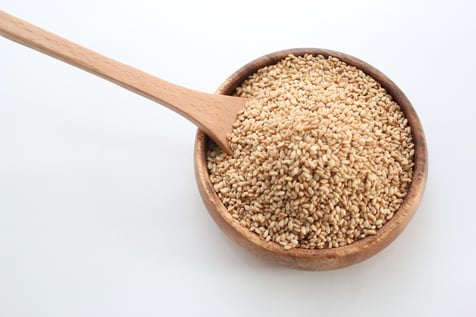Sesame seeds are obtained from the sesame plant Sesamum Indicum. They are cultivated for their uses in food and garnishing, and they are also cultivated for their rich oil. 44% to 60% of their content is cooking oil which is known for a rich, nutty smell.
Sesame seeds have also become very popular as an aesthetic on burger buns. But where do sesame seeds come from?
The sesame plant only grows in tropical, subtropical, and southern temperate regions of the world, and they are exported around the world from developing countries such as India, Myanmar, and Sudan.

Overview of Sesame Seed Production
If you ever wondered how sesame seeds are made, the following will be interesting. Sesame seeds are taken from the sesame fruit. When the sesame plants start producing ripe fruits, the fruits are plucked and dried, and when they are properly dried, they start to open. At this point, the fruit is shaken so that the seeds fall out. When the sesame seeds fall out, they are usually hulled from their shells. But they can be eaten with the shells on. Read on why sesame seeds are good for you.
The three main regions where sesame seeds come from are:
In this blog, we will be looking into the details of sesame seed production in each of them.
Sesame Seed Production in India
India is the largest exporter of sesame seeds and the second-largest producer. The sesame plant can be grown in all regions across India as the climate there is favourable for its growth. However, sesame plants are mainly grown in the western, eastern, and south-central areas of India because they are close to the seaports. This also makes transportation costs lower.
It’s also worth noting that sesame seed production is usually done manually, as cost-effective manual labour lower production expenses. That being said, parts of the dehulling process are done with machines.
After the seeds have been harvested and dehulled, the seeds are stored in one-layer plastic-coated bags. Sesame seeds absorb moisture easily, so materials that repel moisture need to be used to store it. Other storage alternatives include propylene bags and sealed, corrugated cartons. Learn the difference between white and black sesame seeds.
Sesame Seed Production in Myanmar
Sesame seeds can grow all year round in Myanmar, and they make up a huge part of the local diet. They have been cultivated in this region for a long time with records of sesame seed production in Myanmar dating as far back as 1044AD.
The sesame seed plant is mainly grown in the lowland middle regions of Myanmar. This area is dry and receives the least amount of rainfall, which are apt conditions for the development of the sesame plant.
Myanmar also shares 15% of the global sesame trade. It is becoming more popular in global trade as it is free from any dust, dirt, or any other kind of impurity such as pesticides. Efforts are being made to increase the yearly export rate of sesame seeds and 33 private companies currently export sesame seeds from Myanmar.
Sesame Seed Production in Sudan
In 2015, Sudan was the second-largest exporter of sesame seeds. The first was and still is India. At the time, their sesame seed exports accounted for 13% of the global share, yet, the production of sesame seeds in Sudan is fraught with challenges.
Production rates are unstable and unpredictable due to fluctuations in annual production. These fluctuations are due to unpredictable weather conditions, lack of policies, and lack of suitable infrastructure. Only 47% of sesame seed farming is done manually, and 53% is mechanised. Additionally, some parts of Sudan are known to use labour from neighbouring countries such as Ethiopia during the harvest season.
Sesame seeds are also very resilient, and they can survive in times of drought. This is because of their wide network of roots. They also grow in all types of soil and can even improve soil quality. These qualities make it a farmer's favourite in Sudan and other sesame seed growing countries.
So, where do sesame seeds come from? They come from the dried sesame fruit cultivated in developing countries across Asia & Africa by hard-working farmers.
Read 5 ways KODGAV is supplying sesame seeds sustainably.